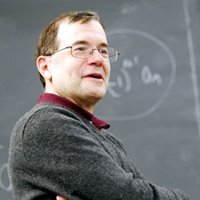Title of Presentation
“Mathematics and Technology: Past and Future”
Mathematics has played an essential supporting role in the development of computers, of communications, and of the internet. A famous talk of Eugene Wigner in 1959 addressed “The Unreasonable Effectiveness of Mathematics in the Natural Sciences”. This talk will describe some examples of the invisible uses of mathematics in products and processes, a consequence of such effectiveness. The speaker will draw on his 30 year experience in industrial research and development at Bell Laboratories. He will describe the environment for mathematicians at Bell Labs that led to extraordinary developments, both theoretical and practical. The power of computers together with universal communication has changed interaction in the larger society. The talk will discuss how these developments feed back on doing mathematics, changing how mathematicians think as well as what they can do.
Profile
- Web Site URL
- http://www.math.lsa.umich.edu/~lagarias/
- A brief Biography
-
Jeffrey Lagarias received his PhD in mathematics in 1974 in analytic and algebraic number theory. He worked at A.T. & T. Bell Laboratories from 1974 to 2004 in both development and research areas. In 2004 he joined the faculty of the University of Michigan where he is now Harold M. Stark Collegiate Professor of Mathematics. He has held visiting positions in computer science and in physics. Besides work in number theory, in industrial mathematics he has contributed algorithms and results in nonlinear optimization (interior-point mathematical programming algorithms), direct search optimization (Nelder-Mead algorithm), discrete and computational geometry (packing and tiling problems), theory of wavelets (solutions of dilation equations), mathematical physics (models for quasicrystals), and computer science (integer relation algorithms, computational topology). He is a Fellow of the American Mathematical Society (AMS), the Society of Industrial and Applied Mathematics (SIAM), and the American Association for the Advancement of Science (AAAS).
- Details of selected Awards and Honors
-
Levi Conant Prize, American Mathematical Society 2014
Lester Ford Award, Mathematical Association of America 2007, 1986
- A list of selected Publications
-
This list of publications were selected according to relevance to work at Bell Laboratories.
J. C. Lagarias, H. L. Montgomery and A. M. Odlyzko, A bound for the least prime ideal in the Chebotarev density theorem, Inventiones math. 54 (1979), 271-296
J. C. Lagarias and A. M. Odlyzko, Solving Low-Density Subset Sum Problems, Journal of the Association for Computing Machinery (JACM) 32 (1985), 229-246
J. Håstad, B. Just, J. C. Lagarias and C. P. Schnorr, Polynomial time algorithms for finding integer relations among real numbers, SIAM J. Computing 18 (1989), 859-881.
D. A. Bayer and J. C. Lagarias, The non-linear geometry of linear programming I. Affine and projective scaling trajectories, Trans. Amer. Math. Soc. 314 (1989), 499-526
I. Daubechies and J. C. Lagarias, Two-scale difference equations I. Global regularity of solutions, SIAM J. Math Anal. 22 (1991), 1388-1410
J. C. Lagarias, Meyer’s concept of quasicrystal and quasiregular sets, Comm. Math. Physics 179 (1996), 365-376.
J. C. Lagarias, J. A. Reeds, M. H. Wright and P. E. Wright, Convergence behavior of the Nelder-Mead simplex algorithm in low dimensions, SIAM J. Optimization 9 (1998), No. 1, 112-147
J. Hass, J. C. Lagarias and N. Pippenger, The computational complexity of knot and link problems, Journal of the ACM 46 (1999), 185-211
J. C. Lagarias, Mathematical quasicrystals and the problem of diffraction, in: Directions in Mathematical Quasicrystals, (M. Baake and R. V. Moody, Eds.), CRM Monograph Series, Vol. 13, Amer. Math. Soc.: Providence, RI, 2000, pp. 61-93.
J. C. Lagarias (Editor), The Kepler Conjecture: The Hales-Ferguson proof, by Thomas C. Hales, Samuel P. Ferguson, Springer-Verlag: New York 2011.






